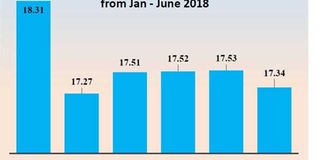What experts say about BoT decision to cut discount rate

What you need to know:
- Reacting to the central bank’s decision to review, last weekend, the discount rate that is applicable to lending to commercial banks to 7 from 9 per cent with effective from August 27, experts said the excitement in both the social and mainstream media in anticipation of an immediate reduction of commercial banks’ lending rates was misguide.
Dar es Salaam. Borrowers should not expect decreased borrowing rate anytime soon, despite the dramatic decrease in Bank of Tanzania (BoT) discount rate, banking professionals have revealed.
Reacting to the central bank’s decision to review, last weekend, the discount rate that is applicable to lending to commercial banks to 7 from 9 per cent with effective from August 27, experts said the excitement in both the social and mainstream media in anticipation of an immediate reduction of commercial banks’ lending rates was misguide. This is because there were other factors at play that determine whether lending rates may go down or not.
A statement BoT released last Friday said; “This review reflects the continued need to promote credit growth for supporting economic activities.”
The revised discount rate has also taken into account the prevailing monetary policy stance and recent development in the 91-day and 182 day treasury bills yields, says BoT.
The central bank’s policy move came after it had lowered yields for government debt instruments to below seven per cent from double digits two years ago, all to encourage banks from lending to private sector.
But experts say the effect of the policy move would be immediate as it will take time for banks to reduce lending rates.
Speaking to BusinessWeek, a business consultant and managing director of TMS Consulting Ltd, Mr Sebastian Kingu, said borrowers will have to wait for a period of two to three years to enjoy declined costs of borrowing.
“Impact of the revised discount rate will take two to three years to effect on borrowing rates from where it is right now,” said Kingu.
Mr Kingu further explains that the initiatives of reducing the discount rate by BoT intends to revamp the banking industry which has been struggling for a couple of years due to increase in the number of Non-Performing Loans (NPLs).
The review in rates, according to Kingu, is a chain which will go down to impact individual borrowers but it will take time for banking interest rate to adjust their rates downwards.
“Currently most borrowers face challenges on the rate of borrowing because they have to pay more than they generate with some closing businesses, and others have to sell their assets to be able to pay back their loan,” he explains. A commercial bank official who wanted to remain anonymous said that the reduced discount rate by BoT can only be used by banks to borrow funds from BoT when they fail to accumulate funds from deposits. “This approach is not mostly used by banks because it is expensive, and by doing so means the bank lacks enough deposits and this normally is the last resort to be applied,” said the banker.
Another banker said “on practical sense, discount window only help the banks when they are stuck and do not have liquidity and that they only have to use the last window at BoT or discount the bill.”
He was in doubt that the measures won’t immediately help borrowers because high risks in the market as reflected by increasing Non-Performing Loans (NPLs). Banks factor their lending rates on risks in the market and so a reduction in the BoT discount rate might not be enough to lead to an immediate reduction in lending rate.
Professor Prosper Swai from Mzumbe University said the expansionary monetary supply initiative done by BoT which has reduced the discount rate by 2 per cent does not imply that the rate of borrowing will also be reduced by the same amount.
According to him the initiative reduces the cost of capital to commercial bank, while stimulating credit to personal loans and others as well as investment growth in the economy.
“The rate of decline in discount rate does not mean equal decline in borrowing rate, because the lending rate by banks is influenced by not only the decline in discount rate, but many other factors,” said Prof Swai.
He said the decline in rate also does not mean people will be attracted to borrow more.
“The initiative by BoT can influence commercial banks to decrease the rate of borrowing, but that does not mean that borrowers will be attracted to borrow, because borrowing is mostly stimulated by the economic situation in the country. So, we need to wait and see where all this will lead to,” he added.
Prof Haji Semboja, a seasoned economist, said the efforts of BoT to promote credit growth for supporting economic activities would bear fruits only if all other sectors in the economy were performing well.
He explained that even BoT’s reduction of discount rate or banks’ lowering of lending rates will amount to nothing if companies or individuals’ capacity to borrow is low.
“The performance of the banking sector will mostly be determined by the performance of other sectors. If other sectors are not performing well the BoT initiative will not bring about any positive outcome to the economy in general and the banking sector in particular” said Prof Semboja.




